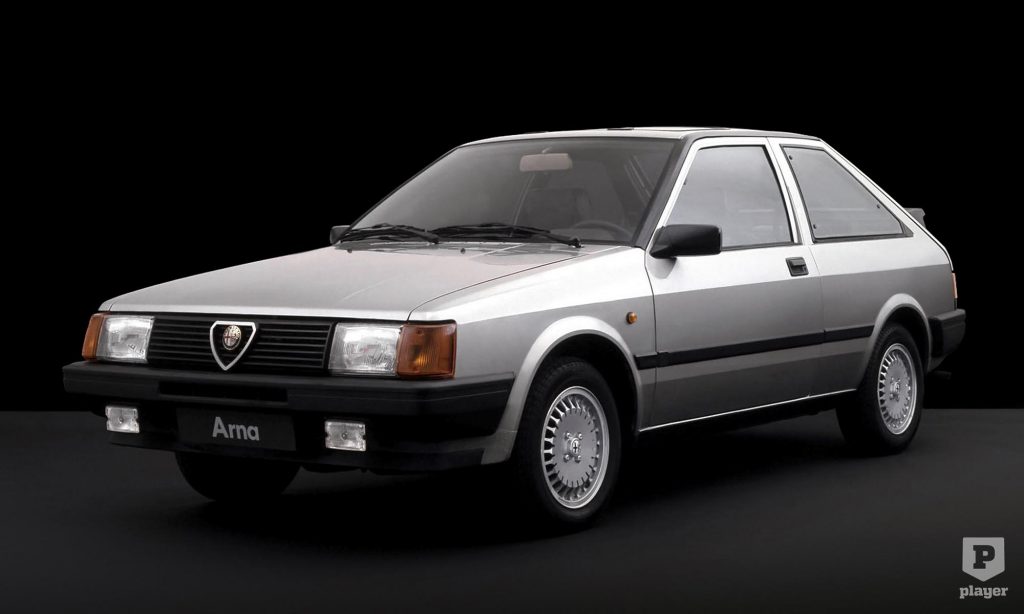Nowadays it is not uncommon for two major car brands to unite and together create something that they would not have been able to do alone, but it is not uncommon for models to simply be rebranded to other brands as well. In addition to the memorable models, there were also plenty of failed attempts, five of which we’ll commemorate.
Alfa Romeo and Nissan
The Arna would have been good if it had combined Italian design with Japanese reliability, but unfortunately what was left of it was Italian assembly quality and the Japanese tendency to rust. It started well, when Alfa Romeo and Nissan formed their joint venture company in 1980, and the acronym Alfa Romeo-Nissan Autovicoli gave the car’s name: Arna.

Unfortunately, just like the name, not enough power has been put into the project in other areas,
Therefore, Arna was nothing more than a Nissan Chery with a Alfasud engine. This combination is well illustrated by the fact that the front chassis came from Alfa, and the rear from Nissan, as well as body parts, which were shipped from Japan to a newly built assembly plant in Naples.

The Arna debuted at the Frankfurt Motor Show in 1983 and remained in production until 1987, during which time 53,000 copies were produced. Alfa Romeo, meanwhile, was passed on to Fiat, and they prioritized the 33 – how well they did it – and Nissan set foot in Europe not with this, but with the opening of the new factory in England.
Cadillac and Pininfarina
Cadillac could have learned from its previous mistake, as already at the end of the fifties it tried to make the Eldorado more valuable by assembling it in Italy, but the project failed. However, in the 1980s, everything seemed possible, and even the Italian studio would be entrusted with the production of the Allanté, a Pininfarina-designed convertible.

General Motors dubbed the production process Allanté Airbridge, and the bodies assembled and polished by Pininfarina were flown by Boeing 747 private jets to Detroit, where they received the American V8s.
Even just writing it down seems like a waste of money, and since only 56 cars fit in one machine, it was also slow.
In addition, the Allanté was not as sporty as the Mercedes-Benz SL and Porsche 928, and there were also problems with its quality. By the end of production, they were mostly corrected, but the Cadillac convertible did not live up to expectations, far fewer than originally planned, 21,000 copies were produced through 1993.
Chrysler and Maserati
The combination of Italian style and American technology was, if possible, worse than its competitors. During his time at Ford, Lee Iacocca befriended Alejandro De Tomaso, who soon owned a Maserati. Iacocca went to Chrysler, and the two brands agreed in 1984 to produce a joint sports model.

Named the TC by Maserati after the Turbo Convertible, it was hoped that it would improve Chrysler’s image,
Thus the Americans were willing to invest in the ailing Italian manufacturer. The new model was based on the Dodge Daytona, with parts from the Chrysler LeBaron, and its look was similar to the latter, except for the name, there wasn’t much Italian in it.
Due to frequent misunderstandings between Chrysler and Maserati, the project was greatly delayed, and they wanted to sell 5-10 thousand copies of the car presented in 1988 annually, and in the end only 7,300 cars promised in the contract were completed by 1990. The turbocharged four-cylinder was replaced by a Mitsubishi V6, but even this did not save Chrysler from losing $600 million.
Maserati and Citroen
Before De Tomaso’s era, in 1968, Maserati was already in a difficult financial situation, when Citroën bought the famous Italian brand. During this period, the first mid-engined Maserati, the Bora, was born, and the development of the Quattroporte’s successor also began. However, as a result of the oil crisis that arrived in the 1970s, a cost effective solution had to be devised.

The technical basis was therefore provided by Citroën’s decentralized touring car, the SM, and the Quattroporte were likewise front-wheel drive, with a powerful six-cylinder engine, hydraulic suspension and cornering headlights.
His figure drawn with all straight lines is not usually mentioned among Marcello Gandini’s most memorable works.
Maserati tried to cover up the French rules, but this drove up the costs. In 1975, Citroën announced the liquidation of Maserati, and the only reason the brand had not been discontinued was its takeover by Alejandro de Tomaso, one of whose first steps was to discontinue the Quattroporte. With its successor, they never made that mistake again—the Giugiaro-designed car’s V8 engine drove the rear wheels.
Honda and Triumph
At the end of the 1970s, British Leyland began negotiations to develop joint models with Honda, but their first attempt did not go well. The Triumph rationalization introduced at the beginning of the 1980s was so uninteresting that they eventually decided to discontinue the English brand known for its models.

Welcome would have had a great advantage if it had been manufactured in the Economic Community, the predecessor of the European Union, thus bypassing restrictions on Japanese imports. It began being produced at Britain’s Leyland factory in Oxford in 1981, and although its quality wasn’t an issue, it was enough to look at it to see that it had nothing of the Triumph past.
By 1984, more than 133,000 copies had been produced, but even that wasn’t enough for Triumph to survive. However, the British Leyland and Honda were not afraid of failure, and in the 80-90s they produced several joint models, and almost simultaneously the entire Rover range was based on the Japanese manufacturer’s technology, which had slightly higher sales.
You may also be interested in:






